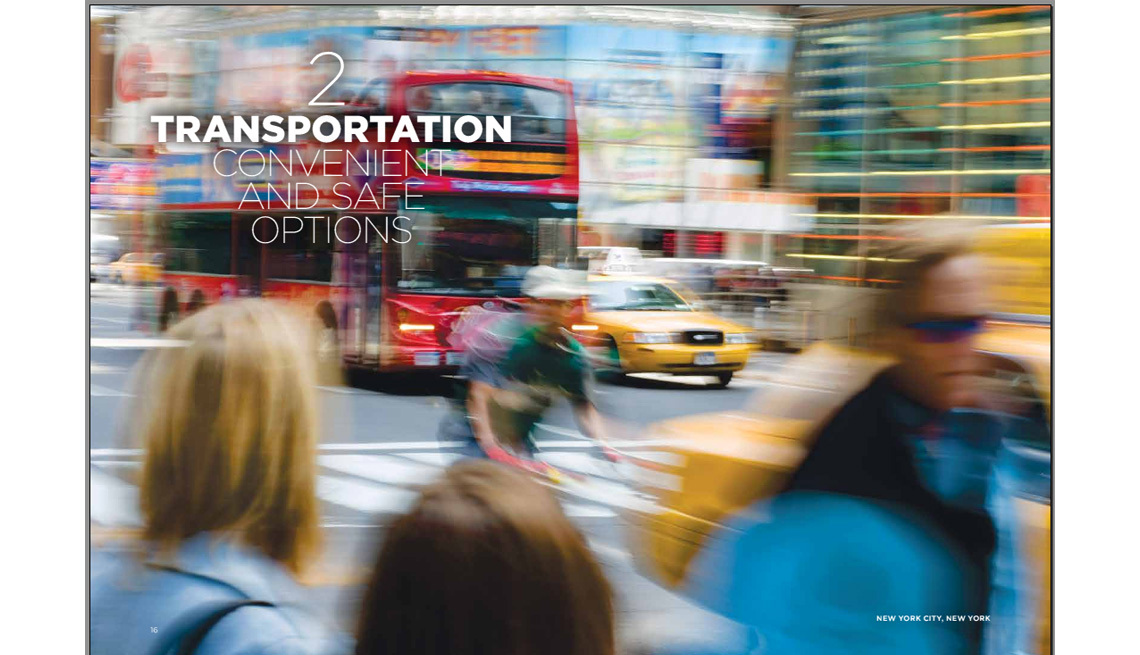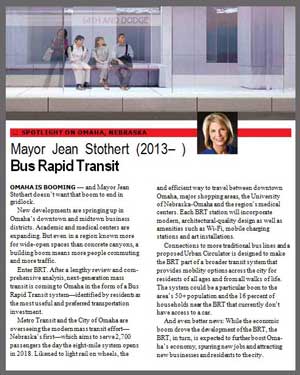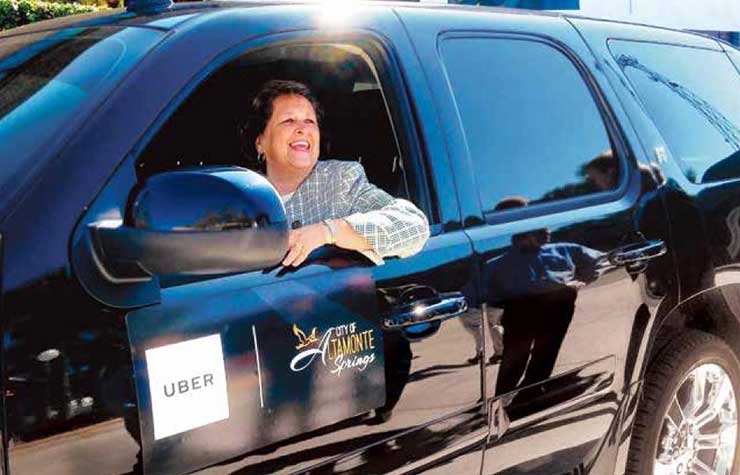Transportation: How Mayors Are Helping People Get Where They Need to Go
A focus on expanding transit options and making walking and biking easier and safer
From public transit to bike lanes and walking paths that encourage outdoor exercise, livable communities provide a variety of transportation options to connect people to jobs, schools, stores.
Subscribe For Free! The AARP Livable Communities e-Newsletter
Without these options, many residents are cut off from opportunities to work, socialize and maintain a daily routine. This is particularly true for older Americans.
Driving becomes challenging as we age and walking gets more dangerous. Pedestrian fatality rates start increasing significantly at age 45, and by age 75 a person is more than twice as likely as a 16- to 20-year-old to die by being hit by a car, according to the National Highway Traffic Safety Administration.
The benefits of improved transportation options are cross-generational. Young people have more options to get to school, families can take public transit to museums or walk to a park and workers of all ages can easily commute to their jobs. And making streets safe for cyclists can boost the bike-to-work movement and exercise opportunities.
Mayors across the country are transforming transportation systems with a focus on expanding transit options and making walking and biking easier and safer.
The Takeaways:
- Infrastructure improvements are still job #1: Filling potholes and keeping sidewalks repaired have always been critical jobs for local government. Today, these basic services are an important foundation for building multimodal transportation systems that serve all ages. As Mayor Kevin Faulconer of San Diego puts it: "If you think driving over a pothole is bad, try hitting one on a bike."
- Cars need to safely share the road with pedestrians and cyclists: More people walking and biking means local governments must rethink their approach to safety on the road. From dedicated bike lanes and improved crosswalks to re-engineered traffic signals and pedestrian-safety programs such as Vision Zero (a global effort to eliminate fatalities and serious injuries from vehicular causes), mayors are taking a holistic approach to safety.
- Investments in public transit help keep people moving: Mayors across the country are encouraging small actions that add up to big impacts for our environment. Person by person, town by town and city by city, communities are making a difference to reduce waste, conserve energy and save habitats.
Here's What Mayors Have Been Doing
Omaha, Nebraska
Mayor Jean Stothert (Term: 2013-)
Bus Rapid Transit
Omaha is booming — and Mayor Jean Stothert doesn't want that boom to end in gridlock.
New developments are springing up in Omaha's downtown and midtown business districts. Academic and medical centers are expanding. But even in a region known more for wide-open spaces than concrete canyons, a building boom means more people commuting and more traffic.
Enter BRT. After a lengthy review and comprehensive analysis, next-generation mass transit is coming to Omaha in the form of a Bus Rapid Transit system — identified by residents as the most useful and preferred transportation investment.
Metro Transit and the City of Omaha are overseeing the modern mass transit effort — Nebraska's first — which aims to serve 2,700 passengers the day the eight-mile system opens in 2018. Likened to light rail on wheels, the system is designed to provide a safe, reliable and efficient way to travel between downtown Omaha, major shopping areas, the University of Nebraska-Omaha and the region's medical centers. Each BRT station will incorporate modern, architectural-quality design as well as amenities such as Wi-Fi, mobile charging stations and art installations.
Connections to more traditional bus lines and a proposed Urban Circulator is designed to make the BRT part of a broader transit system that provides mobility options across the city for residents of all ages and from all walks of life. The system could be a particular boon to the area's 50+ population and the 16 percent of households near the BRT that currently don't have access to a car.
And even better news: While the economic boom drove the development of the BRT, the BRT, in turn, is expected to further boost Omaha's economy, spurring new jobs and attracting new businesses and residents to the city.
Learn more: Website for the City of Omaha
Summary published June 2016
Altamonte Springs, Florida
Mayor Patricia Bates (Term: 2008-)
Uber Partnership
In March 2016, Mayor Patricia Bates launched an innovative transportation program: subsidized Uber rides within city limits. The yearlong pilot provides discounted rides as a way to integrate the on-demand ride service into the city's transportation network and get cars off the road. With a $50,000 commitment, public funds will account for $300,000, while private sponsors will cover the rest.
Bates hopes the program, in addition to providing residents of all ages with a new way to get around town, will encourage citizens to take public transit. Residents receive a 20 percent discount on any ride that begins and ends in the city and 25 percent if it starts or ends at a SunRail commuter station.
Learn more: Website for the City of Alamonte Springs
Summary published June 2016
Atlanta, Georgia
Mayor Kasim Reed (Term: 2010-)
Upgraded Walking and Biking Projects
Mayor Kasim Reed created an advisory committee focused on identifying ways to make Atlanta more bike-friendly and walkable for residents of all ages. Efforts include introducing a bike-share system, appointing a "Chief Bicycle Officer" and making intensive infrastructure improvements. With support from organizations including People for Bikes, Reed is emphasizing the benefits of bicycling — from being a great way to get fit to improving the city's environment.
Learn more: Website for the City of Atlanta | Salt Lake City is a member of the AARP Network of Age-Friendly Communities
Summary published June 2016
Birmingham, Alabama
Mayor William A. Bell, Sr. (Term: 2010-)
Complete Streets
For Mayor William A. Bell, Sr., improving Birmingham's transportation system is all about making connections — among neighborhoods, citizens and community institutions. The foundation for building these connections, both physical and social, is the city's Complete Streets initiative to develop transportation infrastructure that includes walking, bicycling and transit options.
Developed by the National Complete Streets Coalition, the Complete Streets framework aims to make roadways safe for all users. One of Birmingham's major successes is the development of the Enon Ridge Multimodal Corridor and Civil Rights Heritage Trail. When finished, the 29-mile system will include new sidewalks and bike lanes linking the city's major employers, schools, transit and neighborhoods. Signage along roads and walkways will offer the community and visitors information about Birmingham's role in the civil rights movement.
Funded in part through a federal grant, the project also generated significant financial support from local businesses, foundations and nonprofits.
Learn more: Website for the City of Birmingham | Birmingham is a member of the AARP Network of Age-Friendly Communities
Summary published June 2016
Burlington, Vermont
Mayor Miro Weinberger (Term: 2012-)
Go for Gold
For years running, Mayor Miro Weinberger has taken a high-profile multimodal tour of Burlington, highlighting his Go for Gold initiative to make Burlington a world-class walkable city.
Launched in 2013, Go for Gold projects include the installation of more than 750 feet of new sidewalks and pedestrian crosswalks with rapid-flashing beacons along the city's Pine Street corridor, aimed at making walking around town safer for everyone from older residents to young families. New bike and pedestrian-friendly infrastructure is in the works with the help of a broad-based partnership including the University of Vermont, AARP Vermont, the state Health Department, the county planning commission and local business and nonprofit organizations.
Learn more: Website for the City of Burlington
Summary published June 2016
Chattanooga, Tennessee
Mayor Andy Berke (Term: 2011-)
Safe Streets
Safe streets must be safe for everyone — from cars and cyclists to pedestrians, road workers and residents in wheelchairs. That's Mayor Andy Berke's mantra for Chattanooga's participation in the U.S. Department of Transportation's Mayor's Challenge.
With the effort still in its early stages, Chattanooga has passed a Complete Streets ordinance to guide how the city designs, builds and improves its roads and transportation infrastructure. Citizen engagement is an important component, with three action teams focusing on neighborhoods, results and safety. Overall, the city aims to get people out of their cars by creating more pedestrian and bike-friendly transit networks and improving traffic laws.
Learn more: Website for the City of Chattanooga
Summary published June 2016
Clarksville, Tennessee
Mayor Kim McMillan (Term: 2011-)
nMotion 2015
Mayor Kim McMillan's step-by-step approach to reducing traffic includes a range of options to get commuters out of their cars and builds a regional effort to benefit all residents. The city's successful van pool service, operated in coordination with the Regional Transportation Authority of Middle Tennessee (RTA), paved the way for expanded commuter bus service and a study of potential rail service between Clarksville and Nashville.
As chair of the RTA, McMillan is spearheading the region's nMotion 2015 initiative to expand and improve affordable, accessible public transit options. In July 2015, the program launched an ambitious public engagement effort to solicit feedback and plan the region's transportation future. More options mean shorter commute times and higher productivity for workers, easier access to education and job opportunities for the area's young people and access to services and social activities for retirees.
Learn more: Website for the City of Clarksville
Summary published June 2016
Jersey City, New Jersey
Mayor Steven Fulop (Term: 2013-)
Bike Share
Thanks to Mayor Steven Fulop, Jersey City residents have a new way to move around town and get across the river to the Big Apple. In partnership with community leaders, Fulop developed and expanded a bike-share program that connects with New York's 6,000 bike-share system. To Fulop, making the city bike-friendlier is an economic and social priority that gives residents more options to connect with family and friends in New York City as well as explore a wider range of cultural and professional options. Over time, the city plans to supply 350 new bicycles to the bike-sharing program, providing an environmentally friendly travel and recreation option for residents.
Learn more: Website for the City of Jersey City
Summary published June 2016
Los Angeles, California
Mayor Eric Garcetti (Term: 2013-)
Driverless Cars
Mayor Eric Garcetti has a vision: automated, driverless cars that give residents of all ages greater access to safe, convenient and affordable transportation. While the state department of motor vehicles develops appropriate regulations, Garcetti is working with UCLA to make its Westwood neighborhood a pilot location for this futuristic program.
The city's investment in rail and dedicated rapid bus lanes lay the groundwork for a future where residents — from students and young professionals to downsizing empty nesters and retirees — can move from place to place using a driverless ride-sharing system. The city is also partnering with companies such as Xerox to create a one-stop app for multimodal transportation options, making ordering a car, taxi, bicycle or driverless car and coordinating bus or rail travel as simple as ordering a pizza.
Learn more: Website for the City of Los Angeles | Los Angeles is a member of the AARP Network of Age-Friendly Communities
Summary published June 2016
Macon-Bibb, Georgia
Mayor Robert Reichert (Term: 2007-)
Second Street Corridor
Robert Reichert has an optimistic vision for downtown Macon-Bibb as a vibrant walkable and bikable urban center. Construction crews have been busy since 2014 making that vision a reality.
The multiphase project is transforming Second Street from four travel lanes and on-street parallel parking to a more pedestrian, bike- and transit-friendly configuration that features two travel lanes with bike lanes, reverse angle parking and improved sidewalks, shade trees and new benches. Nearby, a pedestrian bridge will connect multi-unit housing with the local university campus, and the city is exploring a state-of-the-art electric bus system designed to make it easier for residents of all ages to get around town and connect with regional transit systems.
Learn more: Website for the City of Macon-Bibb | Macon-Bibb is a member of the AARP Network of Age-Friendly Communities
Summary published June 2016
New York, New York
Mayor Bill De Blasio (Term: 2014-)
Vision Zero
Mayor Bill de Blasio's take on Vision Zero, which he launched in 2014, already appears to be saving lives. According to data released by his office about roadway fatalities and injuries, 2015 was the safest year in New York City history.
The comprehensive initiative stepped up enforcement of traffic laws, improved coordination between local police and transportation officials and invested in infrastructure improvements such as new crosswalks and traffic signals and improved street lighting and signage. Vision Zero builds on a broader commitment — established in coordination with the New York Academy of Medicine and then-Mayor Michael Bloomberg in 2010 — to make New York an age-friendly city and improve safety for older citizens.
Learn more: Website for the City of New York | New York City is a member of the AARP Network of Age-Friendly Communities
Summary published June 2016
Phoenix, Arizona
Mayor Greg Stanton (Term: 2012-)
MultiModal Transportation
Mayor Greg Stanton is leading his city to a more livable future with expanded transportation options for residents of all ages as the centerpiece. A light rail system introduced in 2008 reached its projected 2020 ridership target six years early, and a bike-share program launched in 2014 attracted more than 2,000 members in it first four months.
The latest success is voter approval of a dedicated sales tax increase that will pay for a 42-mile expansion of the light rail system as well as additional bus routes and road improvements. This multimodal approach is designed to help Phoenix residents get to jobs, schools, health services and cultural and social activities without getting behind the wheel — a bonus for young and old alike.
Learn more: Website for the City of Phoenix
Summary published June 2016
San Diego, California
Mayor Kevin L. Faulconer (Term: 2014-)
Fixing Roadways for All
"If you think driving over a pothole is bad, try hitting one on a bike." So says Mayor Kevin Faulconer, an avid cyclist — and an avid supporter of making his city more livable through infrastructure improvements that make it easier and safer for residents of all ages to get around.
Repairs include repaving, filling potholes and improving efforts to track road conditions with a focus on bikers. This kind of simple infrastructure maintenance has a significant impact as citizens find navigating their communities on two wheels safer and more enjoyable.
Learn more: Website for the City of San Diego
Summary published June 2016
San Francisco, California
Mayor Edwin Lee (Term: 2011-)
Vision Zero
If you're going to encourage residents to walk or bike instead of drive, you need to make sure they can do so safely. That's the impetus behind Mayor Edwin Lee's commitment to Vision Zero — achieving zero pedestrian deaths by 2024.
To kick-start the program that launched in 2014, Lee set a target of completing 24 projects in 24 months — a goal that was met three months early. These projects include implementing turn restrictions on a busy section of downtown Market Street, installing painted safety zones and high-visibility crosswalks, modifying traffic signal timing and removing obstructions that impaired visibility at targeted intersections.
The improvements are aimed at helping all San Franciscans — from students and workers, to parents with small children and older residents who walk or use transit instead of driving — get around the city.
Learn more: Website for the City of San Francisco | San Francisco a member of the AARP Network of Age-Friendly Communities
Summary published June 2016
Utica, New York
Mayor Robert Palmieri (Term: 2011-)
Sidewalk Improvement Program
Thanks to improvements in the local economy, Mayor Robert Palmieri, in partnership with the Utica Common Council, was able to reinstate the city's Sidewalk Improvement Program in 2015 after a three-year lapse. Through the program, the city covers up to half of property owners' costs to repair the sidewalks in front of their homes or businesses. The improvements are aimed at enhancing Utica's walkability and making the city clean and safe.
Learn more: Website for the City of Utica
Summary published June 2016
West Hartford, Connecticut
Former Mayor Robert Scott Slifka (Term: 2004-2016)
iTNCentralCT
Mayor Robert Scott Slifka's initiatives demonstrate his commitment to creating accessible and affordable transportation options for all citizens. He started by funding local organizations to brainstorm new approaches for his city.
One successful program launched as a result of this effort is iTNCentralCT, an independent nonprofit agency that provides 24-hour transportation to residents who are 60-plus and those who have visual impairments. Delivering free rides since 2009, iTNCentralCT works in coordination with community and social service organizations to make sure that these residents can get where they need to go.
Learn more: Website for the City of West Hartford
Summary published June 2016
OUR OTHER INSIPIRING RESOURCES INCLUDE
- AARP Livability Fact Sheet Series (pictured)
- AARP Imagining Livability Collection
- AARP Livable Communities Slideshows
- AARP Livable Communities Interviews
- AARP Livable Communities How To's
- AARP HomeFit Guide
- AARP Network of Age-Friendly Communities
- AARP Livable Communities A-Z Archives
The AARP Livability Fact Sheets series and the AARP HomeFit Guide are first-place winners in the Clearmark Awards and the Imagining Livability Design Collection received Platinum-level honors from the 2015 MarCom Awards.
AARP.org/Livable
Enter a topic, name, place, etc.





